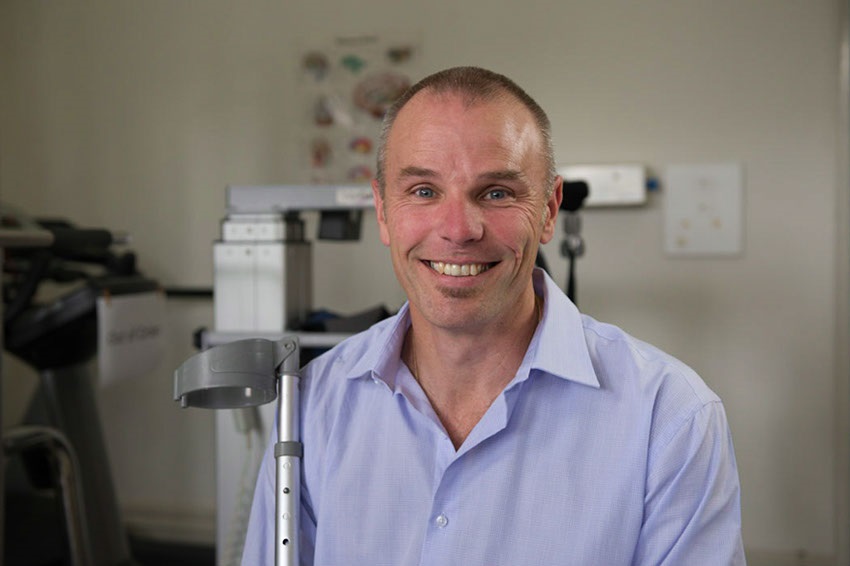Improving mobility after traumatic brain injury with ballistic strength training
-

Prof Gavin Williams
Project Details
Many people with TBI have difficulty walking
Mobility limitations are common following moderate to severe TBI. Reduced walking speed or endurance restricts ability to perform normal activities, access the community, cross roads or keep up with peers. Postural instability associated with gait disorders places survivors of moderate to severe TBI at greater risk of falling. Higher level mobility skills, such as the ability to run, are important for many social, leisure and sporting activities, yet approximately 75% of people with moderate to severe TBI do not resume their pre-morbid activities.
In addition to the impact of TBI on mobility and day to day activities, mobility limitations can have pervasive and extensive physiological and psychological sequelae. Reduced cardiovascular fitness, increased susceptibility to fatigue and reduced ability to exercise aerobically following TBI have been well documented and associated with limited mobility. Several studies have also demonstrated a strong association between mobility limitations and poor emotional health.
The cause of gait disorders following TBI is largely unknown and varies across individuals
In contrast to the vast literature on neuropsychological impairments following TBI, surprisingly little information is known about the effect of the brain injury on gait. Our recent systematic review found the key biomechanical abnormalities of gait were yet to be determined. Further, the key physical impairments contributing to mobility limitations have not been established. Several studies have suggested balance may be primarily responsible. Although balance, spasticity, contracture, strength and coordination may all contribute to mobility limitations, our research has identified that balance and strength deficits are most prevalent, but the primary cause of mobility limitations was muscle weakness.
Effective treatments have not been identified
Physiotherapy is routinely provided to treat the physical impairments that contribute to mobility limitations in order to optimise rehabilitation outcomes for people with TBI. Our results indicate that significant improvements in mobility can be achieved even in those with chronic TBI. Balance training and muscle strengthening programs are widely used. Strong evidence exists indicating balance training improves balance disorders and strength training improves muscle weakness in neurological populations, yet little evidence exists supporting the impact of either intervention on mobility limitations. Further, a recent international symposium on research priorities for TBI highlighted the urgent need for rehabilitative therapy research, as virtually no Level 1 evidence exists.
To date, intensive strength training programs have failed to improve walking following neurological injury. The aim of this multi-centre trial is to implement ballistic strength training for people with TBI during the early recovery phase post-injury, targeted to the three main muscle groups responsible for forward propulsion when walking. This type of strength training is usually performed by athletes and sports people, but preliminary investigations indicate that ballistic strength training may be equally effective for brain injury.
Objectives
The primary aim of this research proposal is to determine whether a 12-week task-specific strength training program is more effective than a 12-week usual care program for improving mobility following TBI.
Researchers
- Matt Kundesvski
- Rachelle Pitard
- Kavya Pillu
- Ines Serrada
- Steph Robinso
Collaborators
- Prof Meg Morris
- Prof Louise Ada
- A/Prof Bryant
- Prof Olver
- A/Prof Clark
- Dr Hassett
Funding
- NHMRC Project Grant (APP1104237) 2016-2019. Improving mobility after traumatic brain injury with ballistic strength training ($661,430).
- 2018 MDHS Research Fellowship. The University of Melbourne. ($67,651.50)
- 2013 Sir Edmund Herring RACV scholarship ($54,000)
- 2014 Mr Kingsley Mills Research grant. Epworth Research Institute. ($48,673)
Research Outcomes
- Williams G, Ada L, Hassett L, et al. Ballistic strength training compared with usual care for improving mobility following traumatic brain injury: protocol for a randomised, controlled trial. Journal of Physiotherapy 2016; 62: 164. DOI: 10.1016/j.jphys.2016.04.003.
- Williams G, Hassett L, Clark R, et al. Improving Walking Ability in People with Neurological Conditions: A Theoretical Framework for Biomechanics-Driven Exercise Prescription. Archives of Physical Medicine and Rehabilitation 2019; 100: 1184-1190. DOI: 10.1016/j.apmr.2019.01.003.
- Australian New Zealand Clinical Trials Registry: ACTRN12611001098921
Research Group
Faculty Research Themes
School Research Themes
Neuroscience & Mental Health, Practice and service improvement, Recovery and Rehabilitation Across the Lifespan
Key Contact
For further information about this research, please contact the research group leader.
Department / Centre
MDHS Research library
Explore by researcher, school, project or topic.